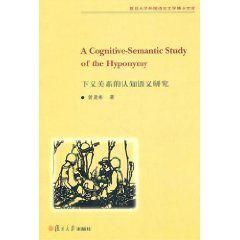內容簡介
《下義關係的認知語義研究》由曾建彬所著。首先通過對相關歷史背景的分析明確下義關係的基本定義,並對下義關係的研究提出了這樣一個理論假設,即認知概念是人類共通的,並且以詞的形式在不同語言中反映出來。因此,我們對下義關係的認知語義研究旨在系統考察詞義的聚合關係,以及認知概念和辭彙意義之間的相互關係。繼而在文獻綜述部分探討不同學科針對下義關係現象所採用的研究方法和取得的研究成果。其次,理論探索部分是運用認知和語義的研究視角對下義關係進行三級分類研究,以便能夠更好地反映人類認知的分類特點,即人類將紛繁複雜的客觀世界簡化為有組織的分類範疇,並對之進行有系統的範疇化和概念化。最後,《下義關係的認知語義研究》的語料分析是針對三級下義關係研究模式的語料檢測,下義關係的英漢對比研究,以及下義關係在詞組、句子、段落和語篇上下文之中的考察等。其中的英漢下義關係對比研究以及上下文之中的下義關係研究從不同側面揭示了不同語言文化環境對於客觀世界所採用的不同分類方式,以及人類語言和人類思維的相互關係。
作者簡介
曾建彬,英語語言文學博士,中國認知語言學會會員,TESOL會員(2001—2002),復旦大學外文學院黨委副書記,大學英語研究生教學部主任,UnitedBoard訪問學者(St.Mary’sCollegeofMaryland,USA,2001—2002)。主要研究領域為認知語言學和英語教學研究。著有《下義關係的認知語義研究》,《英文原著選讀》,《研究生綜合英語》,《博士生英語》,《21世紀大學新英語讀寫譯教程》;“下義關係中的下義詞”,“上下義和上下文”,“基本層次範疇和基本範疇詞”,“對原型的認知框架解析”,“體驗哲學與合作學習”,AnAsian’sViewofAmerica,OnCourseDesignofEnglishforGraduateStudents等。曾先後獲上海市教學成果三等獎(2001),上海市教學成果二等獎(2005),復旦大學研究生教學成果三等獎(2008),CASIO優秀論文獎(2009)等獎勵。曾建彬,英語語言文學博士,中國認知語言學會會員,TESOL會員(2001—2002),復旦大學外文學院黨委副書記,大學英語研究生教學部主任,UnitedBoard訪問學者(St.Mary’sCollegeofMaryland,USA,2001—2002)。主要研究領域為認知語言學和英語教學研究。著有《下義關係的認知語義研究》,《英文原著選讀》,《研究生綜合英語》,《博士生英語》,《21世紀大學新英語讀寫譯教程》;“下義關係中的下義詞”,“上下義和上下文”,“基本層次範疇和基本範疇詞”,“對原型的認知框架解析”,“體驗哲學與合作學習”,AnAsian’sViewofAmerica,OnCourseDesignofEnglishforGraduateStudents等。曾先後獲上海市教學成果三等獎(2001),上海市教學成果二等獎(2005),復旦大學研究生教學成果三等獎(2008),CASIO優秀論文獎(2009)等獎勵。
圖書目錄
Table of Contents
Part One Orientation: Setting the Scene
Chapter One Introduction and Overview
1.1 Historical Survey
1.2 Fundamental Concepts
1.2.1 Hyponymy and inclusion
1.2.2 Sense and concept
1.3 Assumption and Approach
1.4 Book Organization
Chapter Two Hyponymy: Theoretical Survey
2.1 Preliminary Remarks
2.2 Literature Review
2.2.1 Philosophical investigation
2.2.2 Linguistic exploration
2.2.3 Anthropological taxonomy
2.2.4 Psychological analysis
2.2.5 Computer science
2.3 Comments
2.3.1 Philosophical consideration
2.3.2 Cognitive motivation
2.3.3 Semantic study
2.4 Summary
Part Two Theoretical Exploration
Chapter Three Hyponymy: A Cognitive?Semantic Approach
3.1 Preliminary Remarks
3.2 Taxonomic Perspective
3.2.1 Primary and secondary lexemes
3.2.2 Cultural factors
3.3 Prototypical Perspective
3.3.1 A cognitive framework
3.3.2 Basic level category and basic level terms
3.4 Semantic Perspective
3.4.1 A proposed cognitive?semantic approach
3.4.2 The advantages of a three?level hyponymy
3.5 Summary
Chapter Four Hyponymy: A Revised Three?Level Model
4.1 Preliminary Remarks
4.2 A Revised Model
4.3 Advantages of a Revised Model
4.3.1 Cognitive reality
4.3.2 Explanatory adequacy
4.4 Subtypes of Hyponymy
4.4.1 Nominal hyponymy
4.4.2 Verbal hyponymy
4.4.3 Adjectival hyponymy
4.5 Summary
Part Three Linguistic Data Analysis
Chapter Five Hyponymy: Case Study
5.1 Preliminary Remarks
5.2 Hyponymy in English and Chinese
5.2.1 Hyponymy in English
5.2.2 Hyponymy in Chinese
5.3 Hyponymy across Languages
5.3.1 A cross?linguistic study of hyponymy
5.3.1.1 The hyponymy of ‘kan’
5.3.1.2 The hyponymy of ‘xiao’
5.3.2 Lexical Gaps in English and Chinese hyponymy
5.3.2.1 Selectional preferences in Chinese and English hyponymy
5.3.2.2 The compensating mechanism within and across languages
5.4 General Discussion
5.5 Summary
Chapter Six Hyponymy: From Lexicon to Context
6.1 Preliminary Remarks
6.2 Lexical Hyponymy
6.3 Hyponymy in Phrases
6.4 Hyponymy in Sentences
6.5 Hyponymy in Discourses
6.6 Summary
Part Four Conclusion and Preview
Chapter Seven Conclusion
7.1 Achievements
7.2 Limitations
7.3 Direction for Future Study
Bibliography
Appendix
Afterword

